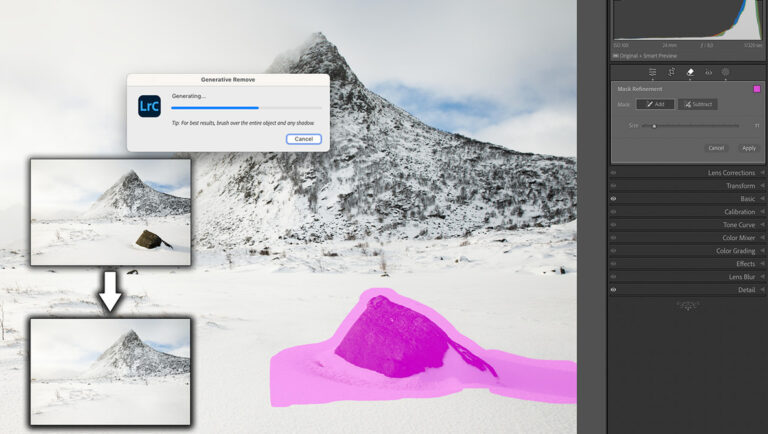The use of AI offers the possibility of creating almost realistic images. This has nothing to do with photography. However, AI can also be used to remove unwanted parts of a photo. Does this feature make us lazy, less attentive when taking pictures? After all, we can easily fix it in post-production.
This is not really artificial intelligence, far from it. It is simply computing power and intelligent algorithms that can create something from a learning process by reading a large number of real images. These images are the photos that we have uploaded online, shared on social networks and that we can find in many other places.
Obtaining the source of these AI training routines is the subject of much protest regarding copyright and ownership. Many people object to the use of their images for training purposes, but at the same time, they happily use AI-generated content to remove unwanted elements or even create complete AI-generated images.
I don’t want to go down this rabbit hole of AI-generated images. But it’s become commonplace to use generative AI tools to fix photos in various ways. I only have experience with the AI generative fill that comes with Photoshop, and recently Lightroom. But other software makers probably have their own versions or will introduce these options soon.
AI-generated content isn’t always necessary
AI generation tools are easy to use and the results are often quite good. Although the new content generated is not reality, in most cases it is indistinguishable. It is tempting to use it every time because the results are very good. On the other hand, it is not always necessary to use AI generative content. After all, we were able to remove the small annoying elements before AI came along.
It may be wise to use AI-generated content sparingly for small fixes. Not only because the photo will be tagged on social media as AI-generated, but also because of the upcoming costs associated with using AI-generated content. Adobe has already announced a point system for using this type of content, and while this has already sparked a lot of angry reactions, I predict that this will become the norm for all AI content providers.
There is another way to prevent the use of AI-generated content. I have observed the way many of my workshop participants work. Some of them become less precise in constructing their composition. Yes, they will look for a subject as they are supposed to, they will choose the best possible location in the frame, but they often neglect to address possible frame disturbances or even the spacing between the frame elements and the frame borders.
If you report any of these issues in the field, they often refer to the post-processing workflow and mention how they will use AI generative content to eliminate the issues. What’s frustrating is how easily these small issues could be avoided in the first place. A simple change in position, perspective, or focal length can be enough. These photographers may be getting lazy because AI can fix everything.
Situations where AI-generated content can be avoided
I have a few examples that I have come across over the past few months. However, I should mention that the photos I used to illustrate the example are from my archives.
Unwanted elements on the edge of the frame
The most common problem with framing is unwanted elements that get stuck to the frame. While this can’t be avoided every time, in most cases it can be done easily. Always check the edges of the frame for these unwanted elements and change your position, perspective, and focal length. This way, you don’t need to use any removal tools, much less AI-generated content.
An element that blocks the view
If you find yourself in a situation where a small element is interfering with your work, try to find a solution. Often, a step to the left or right will suffice; in other situations, it is possible to move closer. Sometimes, the disruptive elements can be used to your advantage by incorporating them into the composition.
People in the frame
We often see examples of AI-generated content in public places where all the people are removed. If desired, it may be possible to wait a few minutes for people to be out of frame. You could even ask people to wait a second before crossing the frame. However, if that is not possible, it may be better to have those people in the frame. After all, that is how reality works.
The framing is too tight
A common problem in composition is tight framing. If it works, it’s good. However, if you need to correct a tilted horizon, you may run into problems if the framing is too tight. This can be fixed with generative AI content, but it’s much easier to make sure the framing isn’t too tight in the first place.
This also applies to bad framing. It is possible to avoid switching from a vertical to a horizontal orientation by adding generative content through AI by taking different photos in a range of compositions and orientations. You can then crop.
Small elements that don’t need AI generative content
Many unwanted objects are often small. It could be a speck of dust on a sensor or small objects that attract negative attention. These small objects often do not need AI generative content. A simple clone brush will suffice with great results.
AI-generated content can be useful
While I try to avoid using AI-generated content, it can sometimes be useful. I appreciate the possibilities it offers, but only if other options fail.
What do you think about AI using generative content? Do you think there is a risk that we will become lazy photographers? Let me know in the comments below.


